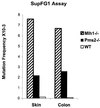Different mutator phenotypes in Mlh1- versus Pms2-deficient mice
- PMID: 10359802
- PMCID: PMC22005
- DOI: 10.1073/pnas.96.12.6850
Different mutator phenotypes in Mlh1- versus Pms2-deficient mice
Abstract
Deficiencies in DNA mismatch repair (MMR) result in increased mutation rates and cancer risk in both humans and mice. Mouse strains homozygous for knockouts of either the Pms2 or Mlh1 MMR gene develop cancer but exhibit very different tumor spectra; only Mlh1(-/-) animals develop intestinal tumors. We carried out a detailed study of the microsatellite mutation spectra in each knockout strain. Five mononucleotide repeat tracts at four different chromosomal locations were studied by using single-molecule PCR or an in vivo forward mutation assay. Three dinucleotide repeat loci also were examined. Surprisingly, the mononucleotide repeat mutation frequency in Mlh1(-/-) mice was 2- to 3-fold higher than in Pms2(-/-) animals. The higher mutation frequency in Mlh1(-/-) mice may be a consequence of some residual DNA repair capacity in the Pms2(-/-) animals. Relevant to this idea, we observed that Pms2(-/-) mice exhibit almost normal levels of Mlh1p, whereas Mlh1(-/-) animals lack both Mlh1p and Pms2p. Comparison between Mlh1(-/-) animals and Mlh1(-/-) and Pms2(-/-) double knockout mice revealed little difference in mutator phenotype, suggesting that Mlh1 nullizygosity is sufficient to inactivate MMR completely. The findings may provide a basis for understanding the greater predisposition to intestinal cancer of Mlh1(-/-) mice. Small differences (2- to 3-fold) in mononucleotide repeat mutation rates may have dramatic effects on tumor development, requiring multiple genetic alterations in coding regions. Alternatively, this strain difference in tumor spectra also may be related to the consequences of the absence of Pms2p compared with the absence of both Pms2p and Mlh1p on as yet little understood cellular processes.
Figures




Similar articles
-
Contributions by MutL homologues Mlh3 and Pms2 to DNA mismatch repair and tumor suppression in the mouse.Cancer Res. 2005 Oct 1;65(19):8662-70. doi: 10.1158/0008-5472.CAN-05-0742. Cancer Res. 2005. PMID: 16204034
-
Alterations in PMS2, MSH2 and MLH1 expression in human prostate cancer.Int J Oncol. 2003 May;22(5):1033-43. Int J Oncol. 2003. PMID: 12684669
-
Elevated mutant frequencies and increased C : G-->T : A transitions in Mlh1-/- versus Pms2-/- murine small intestinal epithelial cells.Oncogene. 2001 Feb 1;20(5):619-25. doi: 10.1038/sj.onc.1204138. Oncogene. 2001. PMID: 11313994
-
Phenotype associated with recessively inherited mutations in DNA mismatch repair (MMR) genes.Biochem Soc Trans. 2005 Aug;33(Pt 4):718-20. doi: 10.1042/BST0330718. Biochem Soc Trans. 2005. PMID: 16042583 Review.
-
Autosomal mutation in somatic cells of the mouse.Mutagenesis. 2003 Jan;18(1):1-6. doi: 10.1093/mutage/18.1.1. Mutagenesis. 2003. PMID: 12473728 Review.
Cited by
-
Genetic reconstruction of individual colorectal tumor histories.Proc Natl Acad Sci U S A. 2000 Feb 1;97(3):1236-41. doi: 10.1073/pnas.97.3.1236. Proc Natl Acad Sci U S A. 2000. PMID: 10655514 Free PMC article.
-
All three MutL complexes are required for repeat expansion in a human stem cell model of CAG-repeat expansion mediated glutaminase deficiency.Sci Rep. 2024 Jun 14;14(1):13772. doi: 10.1038/s41598-024-64480-z. Sci Rep. 2024. PMID: 38877099 Free PMC article.
-
Maternal effect for DNA mismatch repair in the mouse.Genetics. 2002 Jan;160(1):271-7. doi: 10.1093/genetics/160.1.271. Genetics. 2002. PMID: 11805062 Free PMC article.
-
Extrapolating the effect of deleterious nsSNPs in the binding adaptability of flavopiridol with CDK7 protein: a molecular dynamics approach.Hum Genomics. 2013 Apr 5;7(1):10. doi: 10.1186/1479-7364-7-10. Hum Genomics. 2013. PMID: 23561625 Free PMC article.
-
Decreased expression of the DNA mismatch repair gene Mlh1 under hypoxic stress in mammalian cells.Mol Cell Biol. 2003 May;23(9):3265-73. doi: 10.1128/MCB.23.9.3265-3273.2003. Mol Cell Biol. 2003. PMID: 12697826 Free PMC article.
References
Publication types
MeSH terms
Substances
Grants and funding
LinkOut - more resources
Full Text Sources
Other Literature Sources
Molecular Biology Databases

